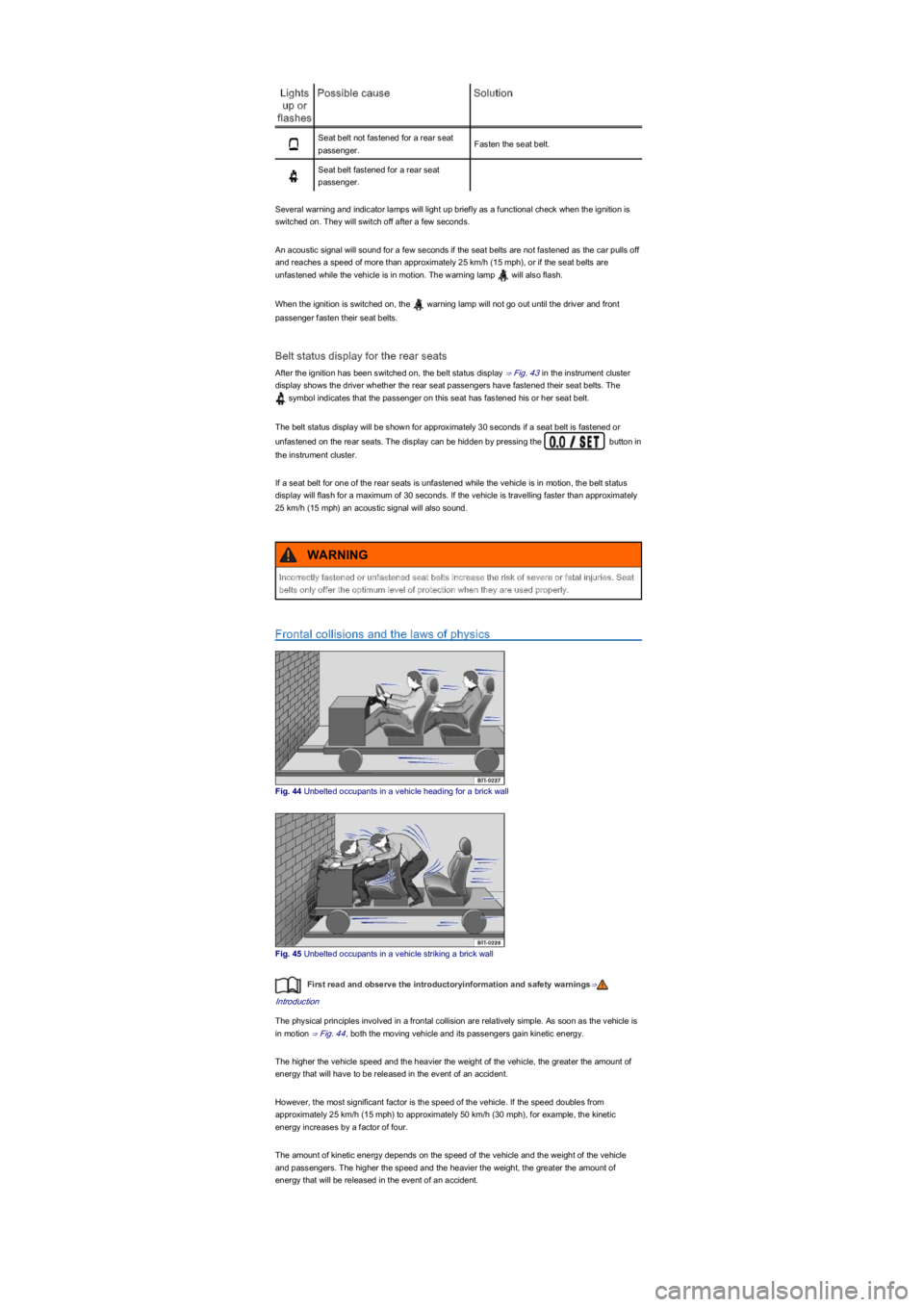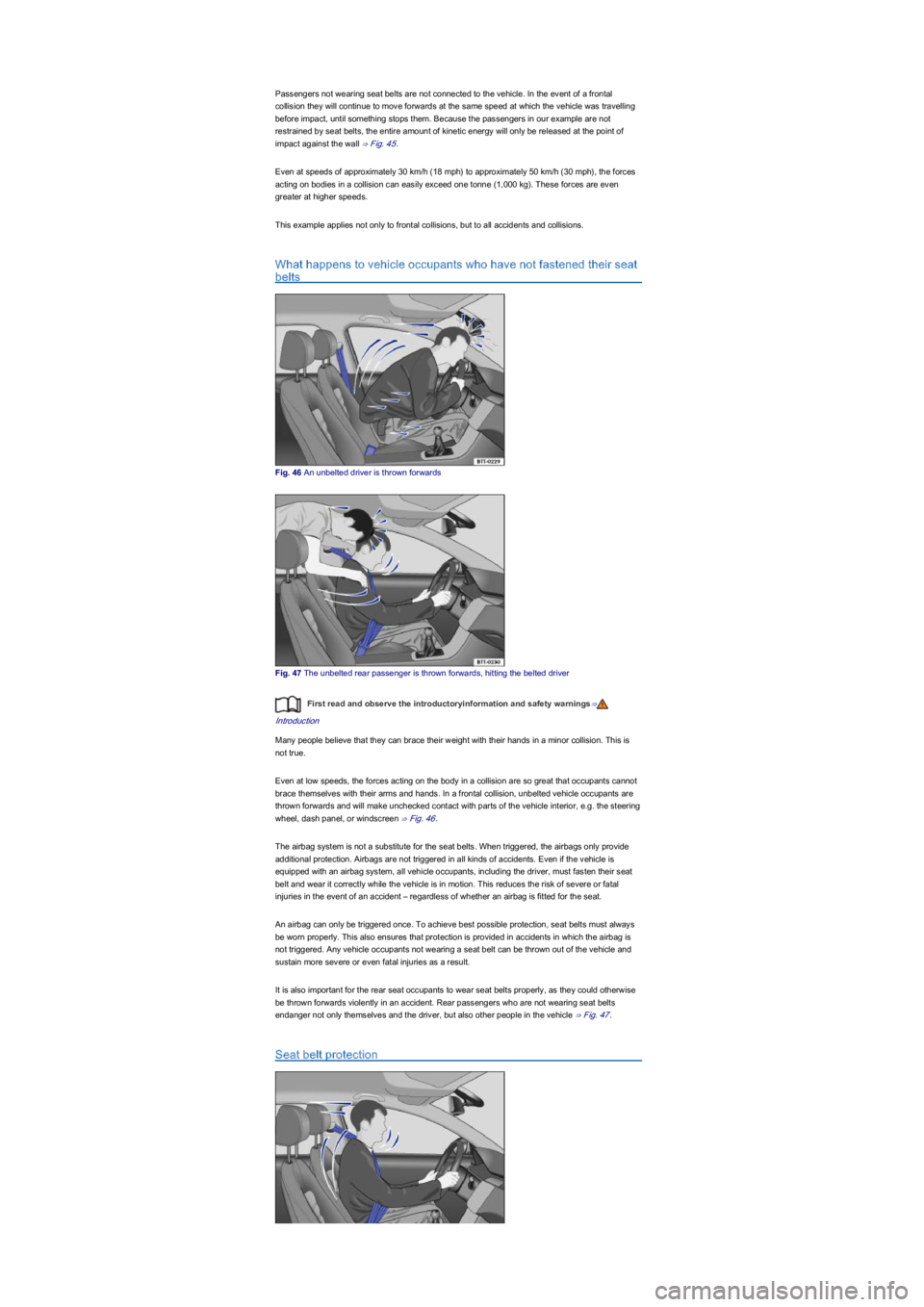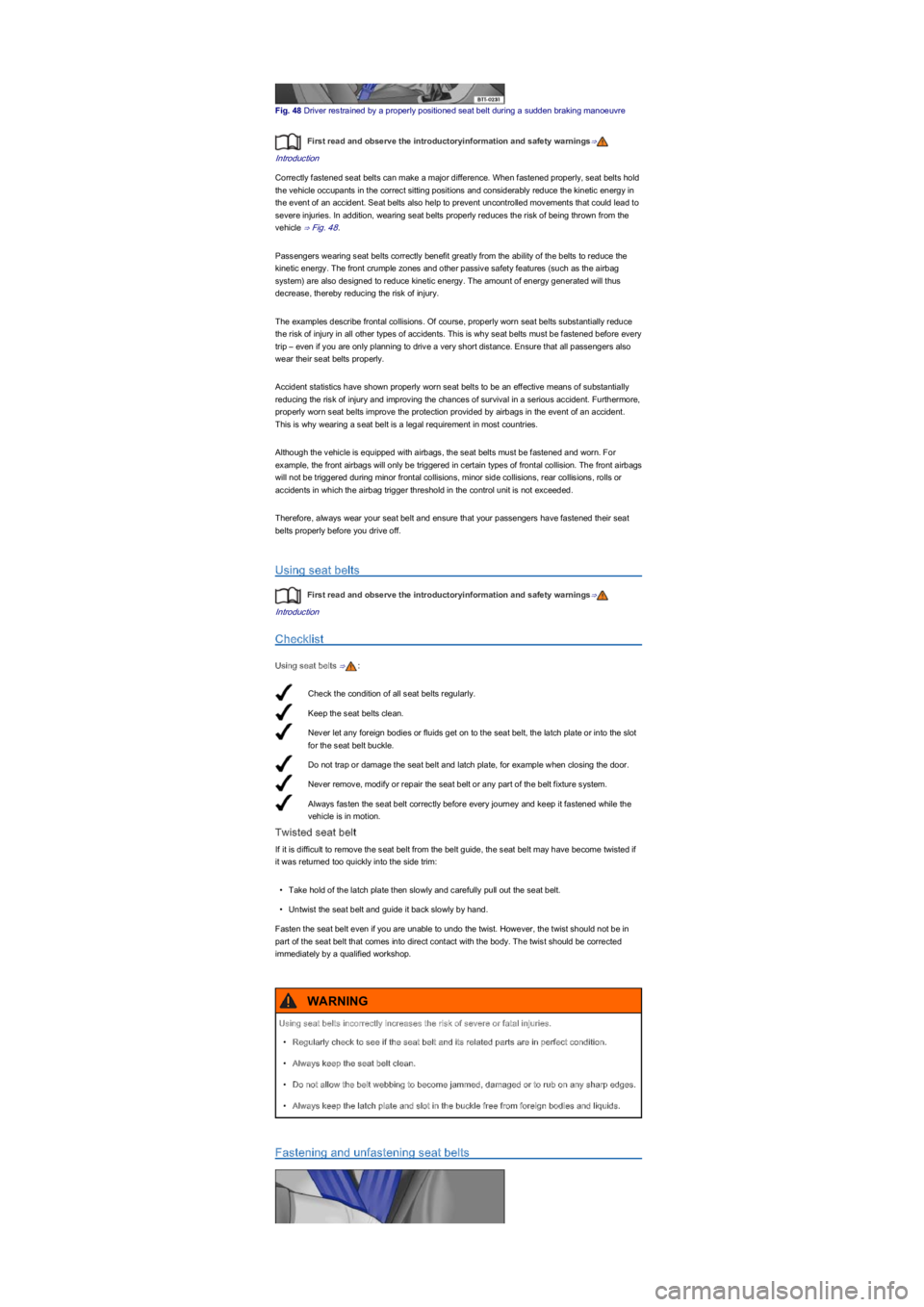Page 34 of 211
The dangers of assuming an incorrect sitting position
First read and observe the introductoryinformation and safety warnings⇒
Introduction
If the seat belts are not worn or are worn incorrectly, the risk of severe or fatal injuries increases.
Seat belts can only provide optimal protection if the seat belt routing is correct. Assuming an
incorrect sitting position considerably impairs the level of protection provided by a seat belt. This
could lead to severe or even fatal injuries. The risk of severe or fatal injuries is especially increased
when a triggering airbag strikes an occupant who has assumed an incorrect sitting position. The
driver is responsible for all vehicle passengers, especially if they are children.
The following list contains examples of sitting positions that could be dangerous for all occupants.
Whenever the vehicle is in motion:
\f
Page 37 of 211
In 4-door vehicles: on the interior side of the seat only.
Adjusting the rear head restraint
Fig. 38 Adjusting rear head restraint
First read and observe the introductoryinformation and safety warnings⇒
Introduction
Every seat is fitted with a head restraint.
The head restraints on the front seats are integrated in the backrest and cannot be adjusted.
The rear seats are fitted with an adjustable head restraint.
Adjusting the height
\f
Page 38 of 211
Removing and installing the rear head restraint
Fig. 39 Removing the rear head restraint
First read and observe the introductoryinformation and safety warnings⇒
Introduction
The rear seats are fitted with an adjustable head restraint.
Removing the rear head restraints
\f
Page 40 of 211

Switch off the seat heating when the seat is not occupied.
FunctionAction ⇒ Fig. 41
Switching onPress the button. The seat heating is switched on at the
highest setting. All indicator lamps light up in the button.
Adjusting the heating
outputPress the button again until the required heating level is set.
Switching offPress the button until the indicator lamps in the button go out.
If the second temperature level has been switched on for more than 15 minutes, it will automatically
switch to the first temperature level. Only one indicator lamp will be lit up.
The seat heating should be switched off as soon as it is no longer needed. Fuel is otherwise
wasted.
Seat belts
Introduction
This chapter contains information on the followingsubjects:
⇒ Warning lamp
⇒ Frontal collisions and the laws of physics
⇒ What happens to vehicle occupants who have not fastened their seat belts
⇒ Seat belt protection
⇒ Using seat belts
⇒ Fastening and unfastening seat belts
⇒ Seat belt routing
⇒ Automatic belt retractor, belt tensioner, belt tension limiter
⇒ Service and disposal of belt tensioners
Check the condition of all seat belts regularly. If the belt webbing, belt connections, belt retractor or
seat belt buckle become damaged, the seat belt in question should be replaced immediately by a
qualified workshop ⇒. The qualified workshop must use correct spare parts that are compatible
with the vehicle, equipment level and model year. Volkswagen recommends using a Volkswagen
dealership for this purpose.
Additional information and warnings:
\f
Page 41 of 211
Warning lamp
Fig. 42 Warning lamp in the instrument cluster
Fig. 43 Seat belt status for the rear seats in the instrument cluster display
First read and observe the introductoryinformation and safety warnings⇒
Introduction
Lights
up or
flashes
Possible causeSolution
The driver seat belt and, if the front
passenger seat is occupied, the front
passenger seat belt are not fastened.
Fasten seat belts.
There are objects on the front
passenger seat.
Remove objects from the front passenger
seat and stow them safely.
Incorrectly fastened or unfastened seat belts increase the risk of severe or fatal injuries. Seat
belts will only offer the optimum level of protection when they are fastened and used properly.
\f
Page 42 of 211

Lights
up or
flashes
Possible causeSolution
Seat belt not fastened for a rear seat
passenger.Fasten the seat belt.
Seat belt fastened for a rear seat
passenger.
Several warning and indicator lamps will light up briefly as a functional check when the ignition is
switched on. They will switch off after a few seconds.
An acoustic signal will sound for a few seconds if the seat belts are not fastened as the car pulls off
and reaches a speed of more than approximately 25 km/h (15 mphyf�����R�U���L�I���W�K�H���V�H�D�W���E�H�O�W�V���D�U�H�
unfastened while the vehicle is in motion. The warning lamp will also flash.
When the ignition is switched on, the warning lamp will not go out until the driver and front
passenger fasten their seat belts.
Belt status display for the rear seats
After the ignition has been switched on, the belt status display ⇒ Fig. 43 in the instrument cluster
display shows the driver whether the rear seat passengers have fastened their seat belts. The
symbol indicates that the passenger on this seat has fastened his or her seat belt.
The belt status display will be shown for approximately 30 seconds if a seat belt is fastened or
unfastened on the rear seats. The display can be hidden by pressing the button in
the instrument cluster.
If a seat belt for one of the rear seats is unfastened while the vehicle is in motion, the belt status
display will flash for a maximum of 30 seconds. If the vehicle is travelling faster than approximately
25 km/h (15 mphyf���D�Q���D�F�R�X�V�W�L�F���V�L�J�Q�D�O���Z�L�O�O���D�O�V�R���V�R�X�Q�G�.
Frontal collisions and the laws of physics
Fig. 44 Unbelted occupants in a vehicle heading for a brick wall
Fig. 45 Unbelted occupants in a vehicle striking a brick wall
First read and observe the introductoryinformation and safety warnings⇒
Introduction
The physical principles involved in a frontal collision are relatively simple. As soon as the vehicle is
in motion ⇒ Fig. 44, both the moving vehicle and its passengers gain kinetic energy.
The higher the vehicle speed and the heavier the weight of the vehicle, the greater the amount of
energy that will have to be released in the event of an accident.
However, the most significant factor is the speed of the vehicle. If the speed doubles from
approximately 25 km/h (15 mphyf���W�R���D�S�S�U�R�[�L�P�D�W�H�O�\�������b�N�P���K���������b�P�S�K�\f, for example, the kinetic
energy increases by a factor of four.
The amount of kinetic energy depends on the speed of the vehicle and the weight of the vehicle
and passengers. The higher the speed and the heavier the weight, the greater the amount of
energy that will be released in the event of an accident.
Incorrectly fastened or unfastened seat belts increase the risk of severe or fatal injuries. Seat
belts only offer the optimum level of protection when they are used properly.
WARNING
Page 43 of 211

Passengers not wearing seat belts are not connected to the vehicle. In the event of a frontal
collision they will continue to move forwards at the same speed at which the vehicle was travelling
before impact, until something stops them. Because the passengers in our example are not
restrained by seat belts, the entire amount of kinetic energy will only be released at the point of
impact against the wall ⇒ Fig. 45.
Even at speeds of approximately 30 km/h (18 mphyf���W�R���D�S�S�U�R�[�L�P�D�W�H�O�\�������b�N�P���K���������b�P�S�K�\f, the forces
acting on bodies in a collision can easily exceed one tonne (1,000 kgyf�����7�K�H�V�H���I�R�U�F�H�V���D�U�H���H�Y�H�Q�
greater at higher speeds.
This example applies not only to frontal collisions, but to all accidents and collisions.
What happens to vehicle occupants who have not fastened their seat
belts
Fig. 46 An unbelted driver is thrown forwards
Fig. 47 The unbelted rear passenger is thrown forwards, hitting the belted driver
First read and observe the introductoryinformation and safety warnings⇒
Introduction
Many people believe that they can brace their weight with their hands in a minor collision. This is
not true.
Even at low speeds, the forces acting on the body in a collision are so great that occupants cannot
brace themselves with their arms and hands. In a frontal collision, unbelted vehicle occupants are
thrown forwards and will make unchecked contact with parts of the vehicle interior, e.g. the steering
wheel, dash panel, or windscreen ⇒ Fig. 46.
The airbag system is not a substitute for the seat belts. When triggered, the airbags only provide
additional protection. Airbags are not triggered in all kinds of accidents. Even if the vehicle is
equipped with an airbag system, all vehicle occupants, including the driver, must fasten their seat
belt and wear it correctly while the vehicle is in motion. This reduces the risk of severe or fatal
injuries in the event of an accident \f
Page 44 of 211

Check the condition of all seat belts regularly.
Keep the seat belts clean.
Never let any foreign bodies or fluids get on to the seat belt, the latch plate or into the slot
for the seat belt buckle.
Do not trap or damage the seat belt and latch plate, for example when closing the door.
Never remove, modify or repair the seat belt or any part of the belt fixture system.
Always fasten the seat belt correctly before every journey and keep it fastened while the
vehicle is in motion.
Fig. 48 Driver restrained by a properly positioned seat belt during a sudden braking manoeuvre
First read and observe the introductoryinformation and safety warnings⇒
Introduction
Correctly fastened seat belts can make a major difference. When fastened properly, seat belts hold
the vehicle occupants in the correct sitting positions and considerably reduce the kinetic energy in
the event of an accident. Seat belts also help to prevent uncontrolled movements that could lead to
severe injuries. In addition, wearing seat belts properly reduces the risk of being thrown from the
vehicle ⇒ Fig. 48.
Passengers wearing seat belts correctly benefit greatly from the ability of the belts to reduce the
kinetic energy. The front crumple zones and other passive safety features (such as the airbag
systemyf���D�U�H���D�O�V�R���G�H�V�L�J�Q�H�G���W�R���U�H�G�X�F�H���N�L�Q�H�W�L�F���H�Q�H�U�J�\�����7�K�H���D�P�R�X�Q�W���R�I���H�Q�H�U�J�\���J�H�Q�H�U�D�W�H�G���Z�L�O�O���W�K�X�V�
decrease, thereby reducing the risk of injury.
The examples describe frontal collisions. Of course, properly worn seat belts substantially reduce
the risk of injury in all other types of accidents. This is why seat belts must be fastened before every
trip \f